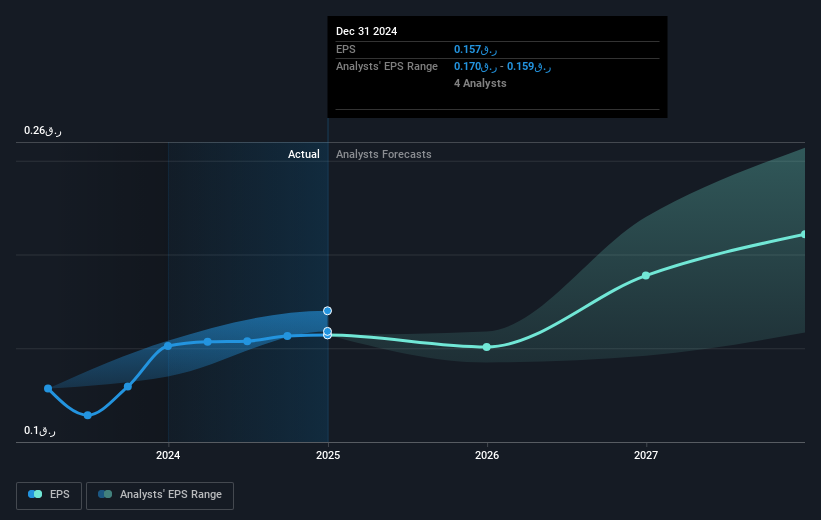Shareholders in Masraf Al Rayan (Q.P.S.C.) (DSM:MARK) are in the red if they invested three years ago
If you are building a properly diversified stock portfolio, the chances are some of your picks will perform badly. But the long term shareholders of Masraf Al Rayan (Q.P.S.C.) (DSM:MARK) have had an unfortunate run in the last three years. Regrettably, they have had to cope with a 62% drop in the share price over that period. Shareholders have had an even rougher run lately, with the share price down 12% in the last 90 days.
Since shareholders are down over the longer term, lets look at the underlying fundamentals over the that time and see if they've been consistent with returns.
We check all companies for important risks. See what we found for Masraf Al Rayan (Q.P.S.C.) in our free report.To quote Buffett, 'Ships will sail around the world but the Flat Earth Society will flourish. There will continue to be wide discrepancies between price and value in the marketplace...' One way to examine how market sentiment has changed over time is to look at the interaction between a company's share price and its earnings per share (EPS).
During the three years that the share price fell, Masraf Al Rayan (Q.P.S.C.)'s earnings per share (EPS) dropped by 10% each year. The share price decline of 27% is actually steeper than the EPS slippage. So it's likely that the EPS decline has disappointed the market, leaving investors hesitant to buy.
The image below shows how EPS has tracked over time (if you click on the image you can see greater detail).

It might be well worthwhile taking a look at our free report on Masraf Al Rayan (Q.P.S.C.)'s earnings, revenue and cash flow.
What About Dividends?
When looking at investment returns, it is important to consider the difference between total shareholder return (TSR) and share price return. The TSR is a return calculation that accounts for the value of cash dividends (assuming that any dividend received was reinvested) and the calculated value of any discounted capital raisings and spin-offs. Arguably, the TSR gives a more comprehensive picture of the return generated by a stock. We note that for Masraf Al Rayan (Q.P.S.C.) the TSR over the last 3 years was -55%, which is better than the share price return mentioned above. This is largely a result of its dividend payments!
A Different Perspective
Masraf Al Rayan (Q.P.S.C.) shareholders are down 8.0% for the year (even including dividends), but the market itself is up 11%. Even the share prices of good stocks drop sometimes, but we want to see improvements in the fundamental metrics of a business, before getting too interested. Regrettably, last year's performance caps off a bad run, with the shareholders facing a total loss of 5% per year over five years. Generally speaking long term share price weakness can be a bad sign, though contrarian investors might want to research the stock in hope of a turnaround. Keeping this in mind, a solid next step might be to take a look at Masraf Al Rayan (Q.P.S.C.)'s dividend track record. This free interactive graph is a great place to start.
Of course, you might find a fantastic investment by looking elsewhere. So take a peek at this free list of companies we expect will grow earnings.
Please note, the market returns quoted in this article reflect the market weighted average returns of stocks that currently trade on Qatari exchanges.
New: Manage All Your Stock Portfolios in One Place
We've created the ultimate portfolio companion for stock investors, and it's free.
• Connect an unlimited number of Portfolios and see your total in one currency
• Be alerted to new Warning Signs or Risks via email or mobile
• Track the Fair Value of your stocks
Have feedback on this article? Concerned about the content? Get in touch with us directly. Alternatively, email editorial-team (at) simplywallst.com.
This article by Simply Wall St is general in nature. We provide commentary based on historical data and analyst forecasts only using an unbiased methodology and our articles are not intended to be financial advice. It does not constitute a recommendation to buy or sell any stock, and does not take account of your objectives, or your financial situation. We aim to bring you long-term focused analysis driven by fundamental data. Note that our analysis may not factor in the latest price-sensitive company announcements or qualitative material. Simply Wall St has no position in any stocks mentioned.
About DSM:MARK
AlRayan Bank Q.P.S.C
Engages in Islamic banking, financing, and investing activities in Qatar and internationally.
Acceptable track record second-rate dividend payer.
Market Insights
Community Narratives




